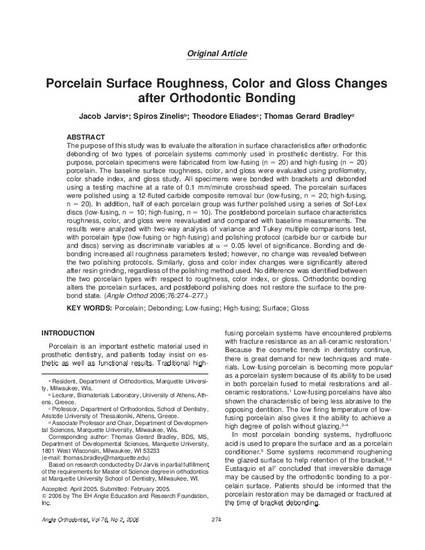
The purpose of this study was to evaluate the alteration in surface characteristics after orthodontic debonding of two types of porcelain systems commonly used in prosthetic dentistry. For this purpose, porcelain specimens were fabricated from low-fusing (n = 20) and high-fusing (n = 20) porcelain. The baseline surface roughness, color, and gloss were evaluated using profilometry, color shade index, and gloss study. All specimens were bonded with brackets and debonded using a testing machine at a rate of 0.1 mm/minute crosshead speed. The porcelain surfaces were polished using a 12-fluted carbide composite removal bur (low-fusing, n = 20; high-fusing, n = 20). In addition, half of each porcelain group was further polished using a series of Sof-Lex discs (low-fusing, n = 10; high-fusing, n = 10). The postdebond porcelain surface characteristics roughness, color, and gloss were reevaluated and compared with baseline measurements. The results were analyzed with two-way analysis of variance and Tukey multiple comparisons test, with porcelain type (low-fusing or high-fusing) and polishing protocol (carbide bur or carbide bur and discs) serving as discriminate variables at α = 0.05 level of significance. Bonding and debonding increased all roughness parameters tested; however, no change was revealed between the two polishing protocols. Similarly, gloss and color index changes were significantly altered after resin grinding, regardless of the polishing method used. No difference was identified between the two porcelain types with respect to roughness, color index, or gloss. Orthodontic bonding alters the porcelain surfaces, and postdebond polishing does not restore the surface to the prebond state.
Available at: http://works.bepress.com/t_bradley/13/

Published version. The Angle Orthodontist, Vol. 76, No. 2 (March 2006): 274-277. Permalink. © 2006 The E. H. Angle Education and Research Foundation Inc. Used with permission.